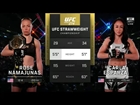Joe Rogan, Jimmy Smith discuss what separates 'the men from the boys' on commentary
- from MMA Junkie on Jan 26, 2018
- 48 views
- Comment
Joe Rogan and Jimmy Smith have collectively called thousands of fights during this careers, and because of that, there’s almost no one more qualified to provide advice on how fight commentary should be done.
Rogan has been part of the UFC for the better part of two decades and has called the majority of the biggest fights in company history. Smith, meanwhile, just signed with UFC as a color commentator earlier this month, but prior he was the face of the Bellator broadcast booth for most of the promotion’s existence.
With so much experience between them, Rogan and Smith know how to do the job, and do it well. During one of Rogan’s recent “Fight Companion” podcasts, the pair got together and discussed some of the intricacies of being a color commentator in MMA.
For starters, Rogan said successful commentator must have a real, undying passion for the sport they’re calling.
“The two most important things are: You’ve actually got to care,” Rogan said. “This has got to be important to you. … You’ve got to care, and it has to mean something to you, and you have to know what the (expletive) you’re talking about. You have to have a deep knowledge of it. You have to really care, and then it should sort of work itself out.”
Smith supported Rogan’s point. However, he also noted the job consists of more than just describing the action of a fight or explaining techniques and strategy. There’s also the broadcast element, which includes keeping fans entertained through various lulls.
One primary criticism from fans and media about both UFC and Bellator events is the pacing of broadcasts. UFC events typically run six or more hours from beginning to end, and keeping viewers engaged is a challenge in itself. Smith notes that the truly great commentators are able to fill in the necessary gaps.
“There are two things that separate the men from the boys, in commentary, and this is the honest truth to me,” Smith said. “I will text Rogan and (Jon) Anik or something when there’s a lot of early knockouts and I’ll be like, ‘How’s it going?’ Because that’s when we have to fill all this time. What you don’t understand in TV is, they’ve booked a two-hour TV show or three-hour pay-per-view, and they’ve got to fill X amount of minutes, period. It doesn’t matter what happens.
“They’ve got to use fights that have already happened, or it’s, ‘Jimmy, interview this fighter. We need five minutes right now.’ So that’s where the tap dance happens, when there’s a lot of early knockouts and you have to fill the time. That’s rough. The other thing is when you have a 25-minute snoozefest. Those two parts are really challenging. In terms of in commentary, those are two things that are really tough. The early knockouts and the boring fights.”
If there’s one thing Rogan and Smith agree in terms of the challenge of working MMA events, it’s the post-fight interviews. Entering the cage moments after a fighter has competed is no easy task, they said, because it’s almost always a situation that happens on the fly.
Conducting an in-cage interview is especially difficult because of the inability to prepare. Rogan and Smith can do as much tape study or create as many pages of notes as they’d like, but when the fight is over, they must go with what’s best in that moment. Rogan said that’s not easy.
“My big fear is that I’m going to be interviewing a fighter after a fight, and then I can’t remember their name when I congratulate them,” Rogan said. “Before I go out there, I will write it. Like if it’s a dude I’ve never seen fight before, and I’m like, ‘Oh (expletive), who is this guy?’ I’ll write his name down, I’ll say it, I’ll repeat it, and I’ll read it back. You might see me walking to the cage, and I’ve got my earpiece in. I’m saying his name because I don’t want to (expletive) it up.”
Smith, who makes his color commentator debut at next weekend’s UFC 221 event, agreed, revealing that there’s an art and balancing act to the post-fight interview.
“You’re not alone, dude; that fear is huge,” Smith said. “Because you’re thinking about what to ask them. Interviewing fighters in the hardest part of the job. If your question is too open-ended, they’ll just go, ‘Yeah.’ You want them to go wherever they want to go, but sometimes if you don’t ask them something specific enough, they’ll go, ‘Yeah, it was.'”
One of Rogan final bits of advice to aspiring broadcasters is to not attempt to overshadow the subjects. Rogan is highly identifiable because of this lengthy UFC tenure, as well as his popularity from outside projects. Few will be in that position, though, and Rogan said it’s important to keep focus on the fighter when conducting interviews.
“I tell people: You are not the show,” Rogan said. “Your question should be just to lead them. I try to have as little personality as I can. I’m just trying to give you the platform. I’m just trying to give you a path to take give your answer. I want you to express what happened in your mind. Maybe there’s some adversity that you had to go through. I want to know how bad it was. But I don’t want to be there. I’m just the guy that has to say those words.”
For more on the UFC schedule, check out the UFC Rumors section of the site.
view original article >>


























